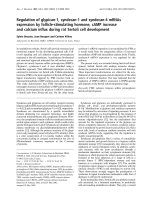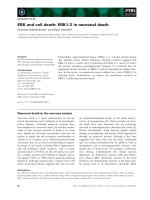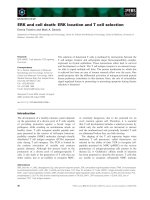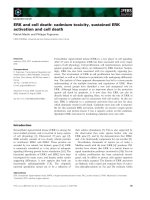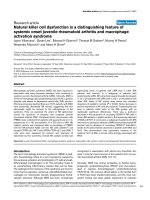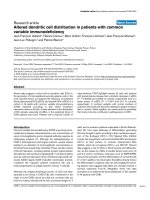Báo cáo Y học: Rapid caspase-dependent cell death in cultured human breast cancer cells induced by the polyamine analogue N1,N11-diethylnorspermine pdf
Bạn đang xem bản rút gọn của tài liệu. Xem và tải ngay bản đầy đủ của tài liệu tại đây (232.88 KB, 7 trang )
Rapid caspase-dependent cell death in cultured human breast cancer
cells induced by the polyamine analogue
N
1
,
N
11
-diethylnorspermine
Cecilia Hegardt
1
, Oskar T. Johannsson
2
and Stina M. Oredsson
1
1
Department of Animal Physiology, Lund University, Sweden;
2
Department of Oncology, The Jubileum Institute, Lund University,
Sweden
ThespermineanalogueN
1
,N
11
-diethylnorspermine
(DENSPM) efficiently depletes t he cellular pools of putres-
cine, spermidine and spermine by down-regulating the
activity of the polyamine biosynthetic enzymes a nd up-regu-
lating the activity of the catabolic enzyme spermidine/
spermine N
1
-acetyltransferase (SSAT). In the bre ast cancer
cell line L56Br-C1, treatment with 1 0 l
M
DENSPM induced
SSAT a ctivity 6 0 and 240-fold at 24 and 4 8 h after seeding,
respectively, which resulted in polyamine depletion. Cell
proliferation a ppeared to be totally inhibited and within 48 h
of tr eatment, there was an extensive apoptotic response.
Fifty percent of the cells were found in the sub-G
1
region, as
determined by flow cytometry, and the presence of apoptotic
nuclei was morphologically assessed by fluorescence
microscopy. C aspase-3 and caspase-9 activities were signifi-
cantly elevated 24 h after seeding. At 48 h after seeding,
caspase-3 and caspase-9 activities were further elevated and
at this time point a significant activation of caspase-8 was
also found. The DENSPM-induced cell death was depen-
dent on the activation of the caspases as it was inhibited by
the general caspase inhibitor Z-Val-Ala-Asp fluoromethyl
ketone. The r esults a re discussed in the light of the L56Br-C1
cells containing mutated BRCA1 and p53,twogenes
involved in DNA repair.
Keywords: apoptosis; breast cancer cells; caspase; DNA
fragmentation; N
1
, N
11
-diethylnorspermine.
The polyamines putrescine, spermidine and spermine a re
cationic m olecules that a re essential f or cell prolifer ation
and differentiation [1]. A number of studies show that they
have a r ole in apoptosis [2–5] as w ell. The biosynthesis and
catabolism of the polyamin es are tightly regulated, which
implicates the i mportance of a balance of polyamine levels
in the cell. Careful regulation of the transport of polyamines
in and out of the cell also participates in keeping the
polyamine pools a t an a ppropriate level f or the ongoing
cellular activities.
The function of the polyamines has been studied by the
use of different biosynthesis inhibitors [1,6]. A d isadvantage
of using t hese inhibitors alone is that they usually fail to
deplete the cells of all three polyamines. Subsequently,
polyamine analogues have been synthesized and some of
them have been shown to efficiently d eplete all cellular
polyamine pools without mimicking the cellular f unctions of
the polyamines [7]. O ne such analogue of spermine is N
1
,N
11
-
diethylnorspermine (DENSPM) which induces a rapid
depletion o f all polyamines by downregulating the activity
of the biosynthetic e nzymes and upregulating the activity of
the catabolic enzyme spermidine/spermine N
1
-acetyltrans-
ferase (SSAT) [8]. The effect of DENSPM treatment has
been studied extensively in different cell lines and animal
tumour models. I n two h uman bladder c ancer cell lines,
DENSPM showe d substantial antiproliferative activity [9].
A number of human solid tumour xenografts were found to
be sensitive to DENSPM, as shown by tumour r egression,
inhibition of tumour growth and sustained antitumour
response [10]. Antitumour activity has also been observed in
human prostate carcinoma cells both in vitro and in vivo
[11,12]. In MALME-3M human melanoma cells, the growth
inhibition induced by DENSPM treatment was subsequent-
ly followed by apoptosis [13]. In SK-MEL-28 human
melanoma cells, DENSPM treatment appeared to induce
growth inhibition and apoptosis concomitantly within 48 h
of DENSPM treatment [14].
Apoptosis is induced via distinct signal transduction
pathways [15,16]. They involve the activation of a number
of caspases that are responsible for many of the morpho-
logical features associated with this kind of cell death.
Caspases can a ctivate one another through proteolytic
cleavage and h ence initiate specific caspase cascades [ 16].
The a ctivation of downstream caspases m ay serve as an
amplification step [17]. The end result i s the cleavage of
proteins and fragmentation of DNA.
We have treated various human breast cancer cell lines
(MCF-7, SK-BR-3, BT-474) with DENSPM and found an
initial growth inhibition followed b y a delayed apoptotic
response (S. M. Oredsson, unpublished results). However,
we have established a human breast cancer cell line
(L56Br-C1) that shows a similar response to DENSPM
treatment as found in human melanoma SK-MEL-28 cells
[14]. There was a n e xtensive growth inhibition and apoptotic
response within 48 h of DENSPM treatment. This led us to
Correspondence to C. Hegardt, Department of Animal Physiology,
Lund University, Helgonava
¨
gen 3B, SE-223 62 Lund, Sweden.
Phone: + 46 46 2229354, Fax: + 46 46 2224539,
E-mail: se
Abbreviations:DENSPM,N
1
,N
11
-diethylnorspermine; pNA, p-nitro-
anilide; SSAT, spermidine/spermine N
1
-acetyltransferase;
Z-VAD.FMK, Z-Val-Ala-Asp fluoromethyl ketone.
Enzyme: SSAT, spe rmidine /spermine N
1
-acetyltransferase
(EC 2.3.1.57).
(Received 4 October 2001, revised 7 December 2001, accepted
18 December 2001)
Eur. J. Biochem. 269, 1033–1039 (2002) Ó FEBS 2002
investigate the mechanism b ehind the DENSPM-induced
cell d eath in the L56Br-C1 cells with the f urther aim o f
identifying the markers for an apoptotic response to
polyamine depletion. The L56Br-C1 cell line w as established
from malignant tissue of a woman with a germ-line
mutation in t he breast cancer associated gene BRCA1.In
addition, the cells also had a mutated p53 gene. The results
are discussed i n the light of finding tumour treatment
regimens that are tailored to individual tumours.
MATERIALS AND METHODS
Materials
Growth medium components were purchased from Bio-
chrom (Berlin, Germany) and tissue culture plastic s from
Nunc (Roskilde, Denmark). DENSPM was purchased
from Tocris Cookson Ltd. (Bristol, UK) and propidium
iodide was obtained from Sigma Chemical Co. ( St Louis,
MO, USA). [Acetyl-1–
14
C]coenzyme A (60 mCiÆmmol
)1
)
was purchased from New England Nuclear, Dupont,
Scandinavia AB (Stockholm, Sweden). Caspase-3, -8, -9
Colorimetric Protease Assay Kits and the ICE-family
protease/caspase inhibitor Z-Val-Ala-Asp fluoromethyl
ketone (Z-VAD.FMK) were purchased from Medical &
Biological Laboratories Co., Ltd. (Nagoya, Japan).
Cell culture
The cell line L S6Br-C1 was established a t t he Department o f
Oncology, the Jubileum Institute, Lund University, S weden
from a p atient belonging t o a family carrying a known
BRCA1 germ-line mutation (O. T. Johansson, unpublished
work). The presence of the germ-line mutation found in the
primary t umour, position 1806 C fi T, was verified in the
cell line (personal communication; A
˚
. Borg, Department o f
Oncology, The Jubileum Institute, Lund University, Lund,
Sweden). Sequencing of the p53 gene revealed a somatic
missense mutation in exon 6, position 644 AGT fi ATT
(amino-acid number 215, i .e. serine is changed to i soleu-
cine), which renders p53 nonfunctional [18].
The cell line was maintained in serial passages in RPMI
1640 medium supplemented with 10% heat-inactivated fetal
bovine serum, 1 0 lgÆmL
)1
insulin, 2 0 ngÆmL
)1
epidermal
growth factor, nonessential amino acids a nd antib iotics
(100 UÆmL
)1
penicillin and 100 lgÆmL
)1
streptomycin).
The cells were s ubcultured once weekly and the growth
medium was exchanged twice between subcultures. The
cultures were incubated at 37 °C in a water-saturated
atmosphere containing 5% CO
2
in air. The growth of the
cells was monitored at each p assage by counting in a
haemocytometer and the cells were regularly grown without
antibiotics to exclude cryptic infections. Cells were thawed
from a frozen stock every 4 months to minimize phenotypic
drift. Cells were seeded in the absence or presence of 10 l
M
DENSPM. DENSPM was made as a 2 m
M
stock solution
in NaCl/P
i
(8 gÆL
)1
NaCl, 0.2 g ÆL
)1
KCl, 1.15 gÆL
)1
Na
2
HPO
4
,0.2gÆL
)1
KH
2
PO
4
, pH 7.3). The solution was
sterilized by filtration, aliquoted and stored at )20 °C. All
treatments were also combined with 10 l
M
Z-VAD.FMK
to ascertain an involvement of caspases where cell d eath was
induced. Both detached (apoptotic cells) and attached cells
were harvested at 24 and 48 h after treatment, pellete d at
900 g for 1 0 min at 4 °C and handled for analyses as
described below.
Polyamine analysis
Cells were stored at )20 °C until an alysis. Chromatographic
separation and quantitative determination of the polyam-
ines in cell extracts in 0.2
M
perchloric acid were carried ou t
using HPLC ( Hewlett Packard 1100), with O-phtaldialde-
hyde as the reagent [19].
SSAT activity analysis
Cells were stored at )80 °C until analysis. Th e cells were
sonicatedin50m
M
Tris/HCl (pH 7.5) containing 0.25
M
sucrose. The a ctivity of SSAT in the sonicate was deter-
mined by measuring the synthesis of [
14
C]acetylspermidine
after incubation with [
14
C]acetyl coenzyme A and spermi-
dine [20].
Flow cytometry and data analysis
Cells were resuspended in ice-cold 70% ethanol and then
stored at )20 °C until an alysis. The c ellular DNA was
stained with propidium iodide-nuclear isolation medium
(NaCl/P
i
containing 100 lgÆmL
)1
propidium iodide, 0.60%
Nonidet P-40 and 100 lgÆmL
)1
RNase A) [21].
Flow cytometric analysis was performed in an Ortho
Cytoron Absolute flow cytometer (Ortho Raritan, NJ,
USA) as previously described [22].
For the computerized analysis of the sub-G
1
peak,
MULTI
2
D
Ò
and
MULTICYCLE
Ò
software programs (Phoenix
Flow Systems, CA, USA) were u sed. Its percentage of the
total DNA histogram was evaluated.
Fluorescence microscopy
Ethanol-fixed cells were stained with propidium iodide-
nuclear isolation m edium. The stained nuclei were then
examined in a fluorescence microscope (Olympus AX70,
Tokyo, Japan) and photographs were taken with an
Olympus DP50.
Caspase activity assay
Cells were resuspended in 5 0 lL o f cell lysis buffer and
stored at )80 °C until analysis. T he caspase activity was
assayed by measuring the c leavage of the chromophore
p-nitroanilide (pNA) from a pNA-labelled substrate accord-
ing t o the manufacturer’s instructions. The assay samples
were incubated with 200 l
M
pNA-substrate at 37 °Cfor2h
before measurement of the absorbance at 405 nm using a
spectrophotometer.
Statistical analysis
For the statisti cal evaluation, a t wo-tailed unpaired
Student’s t-test was used.
RESULTS
When L56Br-C1 cells were seeded in the prese nce of 10 l
M
DENSPM, the ce ll number started to decrease already at
1034 C. Hegardt et al. (Eur. J. Biochem. 269) Ó FEBS 2002
24 h after seeding a nd the cell n umber w as signifi cantly
(P < 0.001) decreased a t 48 h after treatment (Fig. 1). At
48 h after se eding, all DENSPM-treated cells were in fact
detached and the cells were difficult to discern due to
fragmentation. At 72 and 96 h after treatment, it was not
possible to detect any intact cells. All cells were also detache d
after 48 h of t reatment w ith 10 l
M
DENSPM w hen th e d r ug
was added 24 h after seeding (results not sho wn).
To confirm the effect of DENSPM on polyamine
homeostasis, polyamine levels and SSAT activity were
measured. As expected, treatment w ith 10 l
M
DENSP M
resulted in decreased polyamine pools compared to control
(Fig. 2). Putrescine was depleted at 48 h after seeding.
Spermidine was significantly (P < 0.01) decreased at 2 4 h
after treatment and spermine was significantly decreased a t
both 24 (P <0.001)and48h(P < 0.01). The activity of
SSAT was markedly induced with DENSPM treatment
(Fig. 3). A 60-fold increase in activity could be observe d at
24 h, and at 48 h the increase was almost 240-fold
compared to control.
Using various methods, we investigated the nature of the
rapid cell death found in DENSPM-treated L56Br-C1 cells.
Using flow cytometry, we examined if DENSPM treatment
induced a s ub-G
1
peak and i f that could b e reversed by
adding the g eneral caspase i nhibitor Z -VAD.FMK. T he
percentage of cells in the s ub-G
1
region was significantly
(P < 0.001) increased at 24 h with DENSPM treatment,
and a t 48 h approximately 5 0% of the cells were found in this
region (Fig. 4). When trea ting the c ells with 1 l
M
DENSP M,
fragmentation of t he DNA could also be observed, but the
percentage of cells in the sub-G
1
region was l ower than when
treating the cells with 10 l
M
DENSPM (results not shown).
Addition of Z-VAD.FMK to DENSPM-treated cells
decreased the percentage of cells in the sub-G
1
region to
control values (Fig. 4). When studying the propidium
iodide-stained nuclei of DENSPM-treated cells in the
fluorescence microscope, apoptotic bodies could clearly be
seen (Fig. 5). The appearance of apoptotic bodies was
prevented with t he addition o f Z-VAD.FMK.
Caspase-3, - 8 and - 9 were a ctivated in L56Br -C1 cells
treatedwithDENSPM(Fig.6).Asignificant(P <0.05)
Fig. 1. The e ffect of D ENSPM tre atment on the pro liferation o f L56Br-
C1 cells. At time 0, cells were seed ed in the absence or presence of
10 l
M
DENSPM. Results are presented as mean values (n ¼ 24 at
24 and 48 h; n ¼ 3 at 72 and 96 h). Bars represent ± SEM. When not
visible, they are covered by the symbols. s, Control cells;
d, DENSPM-treated cells. ***, P < 0.001.
Fig. 2. The effect of DENSPM treatment on the polya mine content of
L56Br-C1 cells. Cellswereseededintheabsenceorpresenceof10l
M
DENSPM. The results are presented as mean values (n ¼ 6) and bars
represent ± SEM. White b ars, control cells; black bars, DENSPM-
treated cells. **, P < 0.01; ***, P < 0.001.
Ó FEBS 2002 Apoptosis induced by a polyamine analogue (Eur. J. Biochem. 269) 1035
increase in caspase-3 a ctivity could b e observed a t 24 h
compared to control, and at 48 h the increase in activity was
even higher. A significant (P < 0.001) increase in caspase-8
activity was observed but not until 48 h a fter treatment.
Caspase-9 a ctivity was significantly higher in DENSPM-
treated cells at both 24 (P < 0.05) and 48 h (P < 0.001)
after seeding even though the activity was low at 24 h.
DISCUSSION
In most cell lines and animal tumour models, the effect of
DENSPM treatment is g rowth inhibition. Cytotoxic effects
have mostly been seen with chronic exposure of the d rug.
Rapid and extensive induction of cell death (within 48 h of
treatment) h as been observed in SK-MEL-28 cells [14], a
human melanoma cell line t hat contains a m utated p53
gene. In the present work, DENSPM was also found to
rapidly a nd extensively induce cell death in the human
breast cancer ce ll line L56Br-C1. This cell line carries a
germ-line mutation ( 1806 C fi T) in the BRCA1 tumour
Fig. 3. The effect of DENSPM treatment on the activity of spermidine/
spermi ne N
1
-acetyltransferase (SSAT) in L56Br-C1 cells. Cells were
seeded in the absence or presence of 10 l
M
DENSPM. The results are
presented as mean values ( n ¼ 6) and bars represent ± SEM. White
bars, control cells; black bars, DENSPM-treated cells. *, P < 0.05;
***, P < 0.001.
Fig. 4. The percentage of cells in the sub-G
1
region as a measure of
apoptotic cells. The L56Br-C1 cells were seeded in the absence or
presence of 10 l
M
DENSPM with or without the addition of the gen-
eral c a spase inhibitor Z-VAD.FMK. T he results are presented as mean
values (n ¼ 10 for control or DENSPM-treated cells; n ¼ 3for
Z-VAD.FMK t reatment; n ¼ 7forDENSPM+Z-VAD.FMK
treatment) and b ars r epresen t ± SEM. W hite bars, control c ells; black
bars, DENSPM-treated cells; light grey bars, Z-VAD.FMK-treated
cells; dark grey bars, DENSPM- and Z-VAD.FMK-treated cells. ***,
P < 0.001 compared to control cells. , P < 0.01; , P <0.001
compared to DENSPM-treated cells.
Fig. 5. Propidium iodide-stained nuclei o f
L56Br-C1 cells. Cells w ere seeded in the
absence or presence of 10 l
M
DENSPM with
or without t he a ddition o f Z -VAD.FMK. T he
diameter of an intact nucleus is 20–25 lm.
Results presented are from one representative
experiment.
1036 C. Hegardt et al. (Eur. J. Biochem. 269) Ó FEBS 2002
suppressor gene, the most c ommonly detected alteration in
hereditary breast cancer. The BRCA1 protein is thought
to have a role in DNA repair and cell cycle control [23,24].
The cells also have a somatic p53 mutation. The high
sensitivity to DENSPM is interesting in light of the fact that
the tumour in the patient was highly refractive to various
anticancer treatment r egimens including chemotherapy and
radiotherapy. D ENSPM a nd other polyamine a nalogues
are presently undergoing Phase I and Phase II clinical
evaluations in the US.
In L56Br-C1 cells, DENSPM treatment induced an
increase in SSAT activity, which resulted in a decrease in the
polyamine pools. The spermine analogue thus activated the
catabolism of the natural polyamines. DENSPM presum-
ably also decreased the activities of biosynthetic enzymes.
However, we have not measured these a ctivities, as the
excessive increase in SSAT is t hought to be the p rimary
cause for the decrease in the polyamine pools. We observed
a 60- and 240-fold increase in SSAT activity at 24 h
and 48 h, respectively, after seeding in the presence of
DENSPM. The correlation between the DENSPM-induced
increase in SSAT activity a nd the cellular outcome (inhibi-
tion of cell proliferation vs. apoptosis) of DENSPM
treatment is not clear. However, a tendency towards higher
sensitivity to the drug with massive induction of the
catabolic enzyme has been observed when comparing
different cell lines [9,12,14]. In the polyamine m etabolic
pathway, the induction of SSAT results in the acetylation of
spermine and spermidine, which are subsequently oxidized
by polyamine oxidase to form spermidine and putrescine,
respectively. In addition, stoichiometric amounts of
acetamidopropanal and H
2
O
2
are formed. These latter
products have also been suggested to be involved in
apoptosis related to analogue induction of SSAT [25]. In
MALME-3M and SK-MEL-28 cells the increase in SSAT
activity was 650- and 900-fold, respectively, 24 h after
seeding [14]. In the former cell lin e, DENSPM treatment
resulted in growth inhibition with a delayed onset of
apoptosis and in the latter cell line, apoptosis was found as
an early r esponse t o D ENSPM t reatment. I n L 56Br-C1
cells, the DENSPM-induced increase in SSAT activity was
not as extensive as in any of those t wo cell lines. The
depletion of the polyamine pools was however, similar in all
three cell lines. The differences in response to DENSPM
treatment are presumably reflected in other genetic lesions
in the cell lines. One d ifference between MALME-3M and
SK-MEL-28 cells is that the former have the wild-type p53
gene, while the latter has a mutated p53 gene resulting in
different activation of various cell cycle check point controls
[14]. B esides having a mutated p5 3 gene, L 56Br-C1 cells
have a mutated BRCA1 gene. As polyamines have a role i n
the stabilization and integrity of DNA [26–28], polyamine
depletion is like ly to be more deleterious in cells where two
genes that are indirectly (p53) and directly (BRCA1)
involved in DNA repair are nonfunctional. BRCA1 is not
mutated in t he MCF-7, SK-BR-3 and BT-474 cell lines
where we have seen a delayed apoptotic response to
DENSPM treatment (S. M. Oredsson, unpublished results).
The MCF-7 ce ll line h as a wild-type p5 3 gene while the o ther
two have a mutated p53 gene.
The results presented suggest that the cell death induced
by DENSPM treatment in L56Br-C1 cells inde ed was
apoptotic. Most Ôstress-inducedÕ apoptotic processes pro-
ceed via the mitochondrial pathway [16] and we believe that
this pathway is a ctivated in DENSPM-treated L56Br-C1
cells. In fact, it has just r ecently been shown that the
mitochondrial a poptotic signalling pathway was activated
in DENSPM-treated SK-MEL-28 cells [25], s upporting our
notion o f the mitochondrial pathway being involved in
DENSPM-induced cell death in L56Br-C1 cells. The
Fig. 6. The effect of DENSPM treatment on the activities of caspase-3,
-8 and -9. L56Br-C1 cells were seeded in the absence or presence of
10 l
M
DENSPM. The re sults are p resen ted as m ean values (n ¼ 6) and
bars represent ± SEM. White bars, control cells; black bars,
DENSPM-treated cells. *, P < 0.05; ***, P < 0.001.
Ó FEBS 2002 Apoptosis induced by a polyamine analogue (Eur. J. Biochem. 269) 1037
pathway involves a change in mitochondrial transmem-
brane potential and in the release of c ytochrome c from
mitochondria. Cytochrome c then binds to apoptosis-acti-
vating factor 1 and procaspase-9 forming the apoptosome
complex that results in activation o f c aspase-9 by proteolytic
cleavage [29]. In this pathway, caspase-3 and -8 are e ffector
caspases activated in turn dow nstream in the cascade [17].
The higher activation of caspase-3 compared to caspase-9
observed in the DENSPM-treat ed L56Br-C1 cells at 24 h
was probably due to the caspase cascade amplification
mechanism. The activated caspase-3 then subsequently
activated caspase-8. Other polyamine analogues besides
DENSPM have been reported to induce cell death,
however, t he molecular mechanisms behind the observa-
tions have so far not been reported [30].
Apoptotic responses induced by a d iverse number o f
signals are thought to be dependent on p53. Potent DNA-
damaging agents are commonly used in cancer chemother-
apy and tumour regression after chemotherapy is caused, at
least in part, by the ability of DNA damaging agents to
activate apoptosis. Mutations in the tumour suppressor p53
gene are the most frequently reported g ene alterations in
human cancers. Many cancers seem to be inherently
resistant to chemotherapy and apoptosis and this has been
attributed to the inactivation of p53 [31]. The successful
treatment of p 53-deficient tumours i s dependent on the
development of therapeutic strategies that preferentially
induce apopto sis in p53-deficient cells. Apparently, the
activation of the mitochondrial apoptotic pathway in
DENSPM-treated L56Br-C1 occurs in a p53-independent
manner. Thus, DENSPM has the potential to be a d rug that
can induce apoptosis in tumours with a mutated p53 gene.
However, a deficiency in p53 is not the sole determinant of a
rapid apoptotic outcome of DENSPM treatment. There are
reports of p53-deficient cells that are inhibited in their
growth with no apoptotic response by treatment with
DENSPM [32,33]. Other cellular defects are involved and as
mentioned above, that may, for example, be important
DNA repair genes.
One aim in the treatment of any cancer is to develop
treatment strategies that are tailored to individual tumours
and patients in order to maximize survival. Treatment
strategies should p referably k ill the t umour cells rather
than just inhibiting their g rowth, although stable g rowth
inhibition might be an acceptable alternative. Another
important property of an anticancer treatment is to
minimize the damage to normal cells. DENSPM and
other polyamine analogues may have different toxic effects
on normal cells and cancer cells. In the p resent study, we
have shown that DENSPM induces mitochondrial depen-
dent apoptosis in L56Br-C1 cells which contain both
mutated BRCA1 and p53 genes. Our aim is to further
clarify the molecular and genetic mechanisms for the
sensitivity to DENSPM in the hope of finding a clinically
usable marker for sensitivity.
ACKNOWLEDGEMENTS
We wish to thank Ewa Dahlb erg for expert t echnical assistance with the
experiments presented in this paper and Lena Thiman for help with the
polyamine analysis. We wish t o thank Dr Bo Baldetorp for the use o f
the flow cytome ter a t the Department of Oncology, The Jubileum
Institute, Lund University, Sweden. This work was supported by the
Swedish Cancer Foundation, the Crafoord Foundation, the Royal
Physiographical Soc iety in Lund, the Mrs Berta Kamprad Foundation,
the G unnar, Arvid and Elisabeth Nilsson Foundation, the IngaBritt
and Arne Lundbergs R esearch Foundation and the Carl Tesd orpfs
Foundation.
REFERENCES
1. Heby, O . (1981) Role of polyamines in the control of cell prolif-
eration and differentiation. Differentiation 19, 1–20.
2. Bru
¨
ne, B., H artzell, P., Nicotera, P. & Orrenius, S. (1991)
Spermine prevents endonuclease activation a nd apoptosi s i n
thymocytes. Exp. Cell Res. 195, 323–329.
3. Desiderio, M.A., Grassilli, E., Bellesia, E. , S alomoni, P. &
Franceschi, C. (1995) Involvement o f ornithine de carboxylase and
polyamines in glucocorticoid-induced apoptosis of rat thymocytes.
Cell Growth Differ. 6, 505–513.
4. Lindsay, G.S. & Wallace, H.M. (1999) Changes in polyamine
catabolism in HL-60 human p romy elogeno us leukaemic cells in
response to etoposide-induced apoptosis. Biochem. J. 337, 83–87.
5. Hegardt, C., Andersson, G. & Oredsson, S.M. (2001) Different
roles o f spermine in glucocorticoid- and Fas-induced apoptosis.
Exp. Cell Res. 266, 333–341.
6. Ja
¨
nne, J., Alhonen, L. & Leinonen, P. (1991) Polyamines: from
molecular biology to clinical applications. Ann. Med. 23, 2 41–259.
7. Porter, C.W. & Bergeron, R.J. (1988) Enzyme regulation as an
approach to interference with polyamine biosynthesis: an alter-
native to en zyme inhibition. In Advances in Enzyme Regulation
(Weber, G., ed.), pp. 57–79. Pergamon Press, New York.
8.Porter,C.W.,Ganis,B.,Libby,P.R.&Bergeron,R.J.(1991)
Correlations between polyamine analogu e-induced in creases in
spermidine/spermine N
1
-acetyltransferase activity, polyamine
pool de pletion, and growth inhibition in h uman melanoma cell
lines. Cancer Res. 51, 3715–3720.
9. Chang, B.K., Liang, Y., Miller, D.W., Bergeron, R.J., Porter,
C.W. & Wang, G. (1993) Effects of diethyl spermine analogues in
human bladder cancer cell lines in culture. J. Urol. 150, 1293 –1297.
10. Bernacki, R.J., Oberman, E.J., Seweryniak, K.E., Atwood, A.,
Bergeron, R.J. & Porter, C.W. (1995) Preclinical antitumor
efficacy of the polyamine analogue N
1
, N
11
-diethylnorspermine
administered by multiple injection or continuous infusion. Clin.
Cancer Res. 1, 847–857.
11. Zagaja, G.P., Shrivastav, M., Fleig, M.J., Marton, L.J., Rinker-
Schaeffer, C.W. & Dolan, M.E. (1998) Effects of polyam ine
analogues on prostatic adenocarcinoma cells in vitro and in vivo.
Cancer Chemother. Pharmacol. 41, 505–512.
12. Schipper, R.G., Deli, G., Deloyer, P., Lange, W.P.H.J., Schalken,
J.A. & Verhofstad, A.A.J. (2000) An titumor activity of the
polyamine analog N
1
, N
11
-diethylnorspermine against human
prostate carcinoma cells. Prostate 44, 313–321.
13. Kramer, D.L., Fogel-Petrovic, M., Diegelman, P., Cooley, J.M.,
Bernacki, R .J., McManis, J.S., Bergeron, R.J. & P orter, C.W.
(1997) Effects of novel s permine analogues on cell cycle p rogres-
sion and apo ptosis in MALME-3M human melanoma cells.
Cancer Res. 57, 5521–5527.
14. Kramer, D.L., Vujcic, S., Diegelman, P., Alderfer, J., Miller, J.T.,
Black, J.D., Bergeron, R.J. & Porter, C.W. (1999) Polyamine
analogue induction of the p53-p21
WAF1/CIP1
-Rb p athway and
G
1
arrest in human melanoma cells. Cancer Res. 59, 1278–1286.
15. Kolesnick, R.N. & Kro
¨
nke, M. (1998) Regulation of ceramide
production and apoptosis. Annu. Rev. Physiol. 60, 643–665.
16. Bratton, S.B., MacFarlane, M., Cain, K. & Cohen, G.M. (2000)
Protein complexes activate distinct c aspase cascades in death
receptor and stress-induced apoptosis. Exp. Cell Res. 256, 27–33.
17. Slee, E.A., Adrain, C. & Martin, S.J. (1999) Serial killers:
ordering caspase activation events in apoptosis. Cell Death Differ.
6, 1067–1074.
1038 C. Hegardt et al. (Eur. J. Biochem. 269) Ó FEBS 2002
18. Cho, Y., Gorina, S., Jeffrey, P .D. & Pav letich, N.P. (1994) Crystal
structure of a p53 tumor suppressor–DNA complex: u nder-
standing tumorigenic mutations. Science 265, 346–355.
19. Seiler, N. & K no
¨
dgen, B. (1985) Determination of polyamines a nd
related compounds by re versed-p hase high-performance liquid
chromatography: improved separation s ystems. J. Chromatogr.
Biomed. Appl. 339, 45–57.
20. Matsui, I., Wiegand, L. & Pegg, A.E. (1981) Properties of
spermidine N-acetyltransferase from livers of rats treated with
carbon tetrachloride and its role in the conversion of spermidine
into putrescine. J. Biol. Chem. 256, 2 454–2459.
21. Thornthwaite, J .T., Sugarbaker, E.V. & Temple, W .J. (1980)
Preparation of tissues for DNA flow cytometric analysis.
Cytometry 1, 229–237.
22. Fredlun d, J .O., J ohansson, M., Baldetorp, B. & Oredsson, S.M.
(1994) Abnormal DN A synthesis in poly amine d eficient c ells
revealed b y bromodeoxyuridine-flow c ytometry technique. Cell
Prolif. 27, 243–256.
23. Scully, R., Chen, J., Ochs, R. L., K eegan, K., Hoekstra, M.,
Feunteun, J. & Livingston, D.M. (1997) Dynamic changes of
BRCA1 subnuclear location and phosphorylatio n state are
initiated by DNA damage. Cell 90, 425–435.
24. MacLachlan, T.K ., Somasundaram, K., Sgagias, M ., Shifma n, Y.,
Muschel,R.J.,Cowan,K.H.&El-Deiry,W.S.(2000)BRCA1
effects on the cell cycle and the DNA damage response are linked
to altered gene expression. J. Biol. Chem. 275, 2777–2785.
25. Chen, Y., Kramer, D.L., Diegelman, P., Vujcic, S. &
Porter, C.W. (2001) Apoptotic signaling in polyamine
analogue-treated SK-MEL-28 hum an m elanoma c ells. Canc er
Res. 61, 6437–6444.
26. Feuerstein, B.G., Williams, L.D., Basu, H.S. & Marton, L.J.
(1991) Implications and c oncepts of polyamine–nucleic acid
interactions. J. Cell. Biochem. 46, 37–47.
27. Basu, H.S. & Marton, L.J. (1995) Biological a nd therapeutic
implications of the effects of polyamines on chromatin conden-
sation. In Polyamines: Regulation and Molecular Interaction
(Casero, R., ed.), pp. 101–128. Springer-Verlag, Heidelberg.
28. Warters, R.L., Newton, G.L., Olive, P.L. & Fahey, R.C. (1999)
Radioprotection o f human cell nuclear D NA by polyamines:
radiosensitivity of chromatin is i nfluence d b y tightly bound
spermine. Radiat. R es. 151, 354–362.
29. Li, P., Nijhawan, D., Budihardjo, I., Srinivasula, S.M., Ahmad,
M.,Alnemri,E.S.&Wang,X.(1997)Cytochromec and dATP-
dependent formation of Apaf-1/caspase-9 complex initiates an
apoptotic protease cascade. Cell 91 , 479–489.
30. McCloskey, D.E., Casero, R.A., Woster, P.M. & Davidson, N.E.
(1995) Induct ion o f programmed cell death in human breast
cancer cells by an unsymmetrically alkylated polyamine a nalogue.
Cancer Res. 55, 3233–3236.
31. Asker, C., Wiman, K.G . & Selivanova, G. (1999) p53-induced
apoptosis as a safeguard against cancer. Biochem. Biophys. Res.
Commun. 265, 1–6.
32. Pegg, A .E., Wechter, R., Pakala, R. & Bergeron, R .J. ( 1989) Effect
of N
1
,N
12
-bis(ethyl)spermine and related compounds on growth
and p olyamine acetylation, c o ntent, and e xcretion in h uman colon
tumor cells. J. Biol. Chem. 264, 11744–11749.
33. Alm, K., Berntsson, P.S.H., Kramer, D.L., Porter, C.W. &
Oredsson, S.M. (2000) Treatment of cells with the polyamine
analog N
1
, N
11
-diethylnorspermine retards S phase progression
within one cell cycle. Eur. J. Bioche m. 267, 4157–4164.
Ó FEBS 2002 Apoptosis induced by a polyamine analogue (Eur. J. Biochem. 269) 1039

